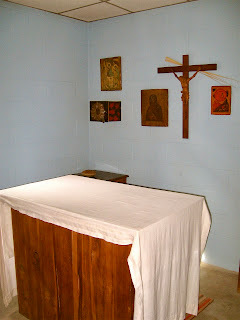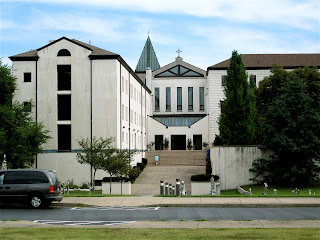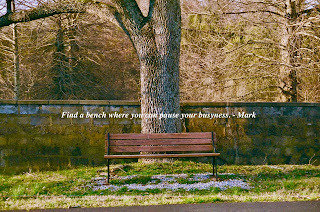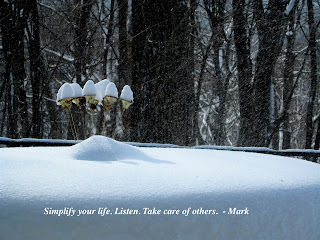R. Mark Liebenow's Blog: Nature, Grief, and Laughter, page 4
July 6, 2024
Two New Essays

I am thrilled to have two essays published recently. Both of them are about grieving someone you love and trying to make sense of the world without them in it.
“Speaking of That … which we weren’t” was published in the Chautauqua Literary Journal. This is a print-only journal, so you can’t read it online.
But “Fragile, Fracture, Fear” is online. It was published by Cleaver Magazine, and this is the link:
https://www.cleavermagazine.com/fragi...
gratefully,
Mark
April 13, 2024
To Be a Hermit

Growing up in a small farming town in Wisconsin, I felt most alive when I was outdoors, and I would sit for hours in the woods or on the shore of a nearby lake and feel that I was home.
When I began reading the words of Thomas Merton fifty years ago, I tried to imagine what it would be like to live as a hermit. Would it be complete isolation, talking only to the wrens and squirrels, and the occasional bear walking by? Or would I be like Thoreau, and come into town now and then to visit people? And where would this hermit place be? A cabin in a forest keeps coming to mind. But what about living in the desert like Georgia O’Keeffe? Or in the highland mountains of Scotland like Nan Shepherd? What landscape could nurture me for the rest of my life?
I also wondered what it would be like to live in Merton’s hermitage that was near Gethsemani Monastery. Reading John Howard Griffin’s book of living in the hermitage while he worked on Merton’s biography gave me a sense of what this would be like.
My essay about this was published in the new Merton Seasonal. It’s called “In the Hermitage with John Howard Griffin.” I am grateful for the insights of Steve Cary and the assistance of Dr. Paul Pearson of the Thomas Merton Center.
(The photo is of the altar in Merton’s hermitage where he celebrated communion.)
April 12, 2024
In Merton's Hermitage with Griffin

My essay in the spring issue of The Merton Seasonal is called “In the Hermitage with John Howard Griffin.” In reading about how Griffin felt living in Thomas Merton’s hermitage for months as he worked on Merton’s biography, I debated whether I would ever want to stay there, if given the chance, as well as if I would want to be a hermit somewhere else.
The Merton Seasonal comes out quarterly from the International Thomas Merton Society. Each issue focuses on exploring Thomas Merton's writings for today's world, and on reviewing new books that have come out about him. If you don’t have a yearly subscription to the Seasonal, you can buy this issue, as well as other earlier issues in stock, for $5 per issue, or 3 issues for $12, 5 issues for $18, postage is included to U.S. addresses.
Checks made payable to “ITMS” should be sent to: Dr Paul M Pearson. Thomas Merton Center, Bellarmine University, 2001 Newburg Road, Louisville KY 40205
April 3, 2024
At Merton's Gethsemani Monastery

At Merton's Gethsemani Monastery Trappist, Kentucky
Pray for us, Thomas Merton,who’ve come for consolation.
Pray for those who rise with the bell at 3 a.m. to touch the incorporeal, who enter heaven’s silenceand wonder if they’ve heard things right.
Pray for the farmer driving holy rolls of Cistercian hay to pay the bills. Pray for monks pouring good bourbon into fruitcake and fudge to sell.
Pray for the cheesemakers filling molds with fresh milk.Pray for those who study mysteries they can never clearly explain.
Pray for the comely lass at Vesperswho distracts from Gregorian chant.
And pray for me, a Protestant in Catholic’s clothing, who meditates under the ginkgo treewhere the Dalai Lama once sat,
who bows at the right time, kneels with the wrong knee, almost remembers to cross himselfwhen passing by the sacred Host.
Pray for us—the confused and fakes, the spectacular failures and saints. Ratchet up our screw-loose hearts.Orphans at your gate.
first published in Liturgical Credo
*
My essay "Tinkering with Grief in the Woods," about spending a week at Gethsemani Monastery while dealing with grief, was published by Literal Latte: https://www.literal-latte.com/2012/09...
March 30, 2024
Easter Dawn

Easter Dawn
The air is cool and hesitant.
Stars twinkle out slowly
as the black sky gives way
to the promise of the hidden sun.
Feelings of longing, belief,
and hope fill my body
and surge with unspeakable joy!
Expectant grays give way
to the pink, orange, and yellow of dawn
as the light of the young sun
rises slowly over dark shadowed trees.
People gather as the sky deepens to blue.
The excited chatter and songs of the birds
lift our hearts that rise
with the steady strokes of wings,
rising towards the unknowable
Presence.
Mark Liebenow
March 27, 2024
Listen
In the morning, before you begin your activities, find a quiet place where you can listen to the day opening up. - Mark

Find a Bench
Simplify Your Life
Prayer
September 2, 2018
This Blog is Moving

This blog is combining with my blog that helps people as they journey through grief, as well as help their friends and family understand what they can do and say to help. http://widowersgrief.blogspot.com
You can also check my full author website at http://markliebenow.com
Or catch me on Facebook, Instagram (MarkYosemite), or Twitter (MarkLiebenow2).






